Although this question sounds basic but, I have been trying to implement this precharge circuit to safely turn on the inverter without overloading the system, however especially when I powered it on, the relay turned on in no time(didn't seem the delaying(timing) works) and I have no clue why, although using a MOSFET do solves it but it gets hot due to turning it on in the linear region.
Here the 3904 here is just to charge the relay slowly and turn it on, after C4 gets charged. The TIP122 here is just to charge the inverter slowly from the capacitor till the relay turn the whole system on(by connecting the inverter to the ground).
The 600 milliohm (R5) here symbolize an inverter(I know it should be kind of inductance and capacitance but just for simplicity) which will draw maximum 24V 40A 1000W.
I need just to charge the capacitor first (C4) then using with the TIP122 to charge the inverter before the relay turns on so the system doesn't get overloaded.
Please if you need more information write in the comments below.
Edit: sorry for the mistake that happened in Q2 I had corrected the schematic.



